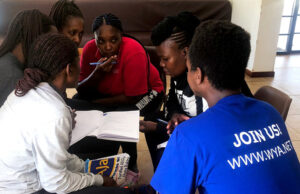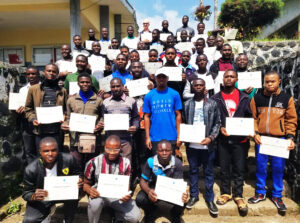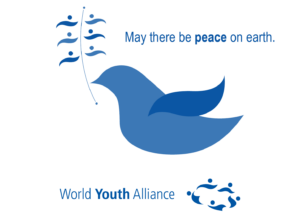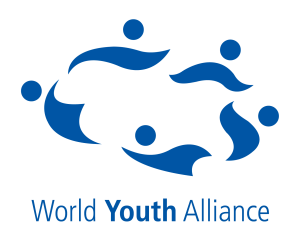“The true soldier fights not because he hates what is in front of him, but because he loves what is behind him.” – G. K. Chesterton
All week long I have been hearing of the fight against HIV/AIDS, I have heard from Bill Clinton that we as the “millions and millions of foot soldiers” must slay the “big dragon” that is AIDS, and have witnessed the militant groups marching about the Global Village shouting for their agenda to be heard and throwing condoms at those who would dare to differ. But, though the first few days of the XVII International AIDS Conference caused me to wonder whether the fight against AIDS was being lost in the vast sea of jargon and agenda, I have since seen great examples of those who truly wish to fight, not for the sake of the disease or for an agenda, but for people, for those who suffer.
Concerning Women
On August 5th I attended a session entitled “Women’s Rights Equal Women’s Lives: Violence Against Women and HIV.” Instead of just speaking about how women were being persecuted, some of the speakers gave concrete instances of how nations and peoples are combating that violence. Dr. Claudia Garcia Moreno spoke of prevention as coming not from just one sector of society but, beginning with the individual and working up through the family, encompassing all members in the society. She gave concrete examples of groups who address concrete aspects of the fight against gender induced violence such as “Yari Dhoshi” for men, and “Somos Iguales, Somos Diferentes” for both men and women.
Although it is necessary for men and women to work together in the fight for equality, another of the speakers, Bufada Khumalo of South Africa, has an organization which works with men and boys to overcome violence against women and realize what masculinity truly is. Khumalo told us that no man is too old to change his ideas of masculinity as he told us of a 60 year old farm hand who laid down the rules of the house with his sons after attending one of Khumalo’s meetings. The farmer had told his sons that they would no longer be waiting for their mother to arrive home from work to cook and clean but would do it for her from now on. “I won’t cook”, he said to his boys, “I’m too old to learn but I’ll do the dishes.” Such a story, though not directly connected to HIV/AIDS, beautifully demonstrated the ability of men to change, to treat women with respect and love and not with an animalistic abuse which could expose her to HIV.
And animalistic abuse is what women are receiving in so many different countries especially in the Democratic Republic of the Congo and Zimbabwe. Yesterday, August 7th, I attended another session on women entitled “Political Crises, Sexual Violence and HIV” where Paula Donovan, executive director of “AIDS-free world”, vividly painted a horrific picture of the evils occurring in the DRC. I cannot tell you what she said but “I could a tale unfold whose lightest words would harrow-up thy soul, freeze they young blood.” I am sorry if such words no longer convey the meaning I intend. Ms Donovan painted a hell I could not have painted using my own imagination. And what horrifies me most is the fact that no one knows of this hell or cares. I am determined to watch, before I watch anything else, the HBO documentary “The Greatest Silence” on the atrocities against women in the DRC. Unfortunately, the talk was solely draining since the only solution offered by Paula Donovan was to lobby to create a permanent woman branch of the United Nations, a branch in the same organization which has only made promises and never acted upon them. There has to be a more grass-roots approach. There has to be.
Concerning Nutrition and Development
There is not just one answer to fight the disease just as there is not one way to live life or even to fight any other disease. The most hopeful and professional of the sessions I attended was “Food Security, Nutrition and HIV” brilliantly moderated by Dr. Alan Whiteside of South Africa. Dr. Nigel Rollins, also of South Africa, and an expert in mother to child transmissions, spoke of what we know concerning the science of nutrition and HIV. In summary, Dr. Rollins said that the HIV pandemic is not just about the virus, it is about the context. The nutritional needs increase by 10% for one infected by HIV. One cannot think of solely eradicating the disease or the transmission of the disease but also of the overall health of the individual. Even though mother to child transmission can occur via breast milk, not breastfeeding one’s child is the greatest cause of death among those infected. Not only do the children need nutritional support, but the mothers do as well.
After Dr. Rollins very scientific explanation of the need for nutrition, we heard from Christine Nabiryo of Uganda who works with TASO to ensure long term food security for those living with HIV, a practical solution for combating the need for nutrition. In the program of working in partnership with other organizations, the clients in the program are trained to have a sustainable livelihood so as to grow or raise their own food and have a means of modest income. The other speakers also told of practical and hope filled methods in which food is being offered to those in need.
Conclusion
Although there were other talks of vital importance which both painted the picture of sorrow (such as the abuses against sex workers) and hope (such as the break-throughs in HIV testing methods) there will be another time and place to speak of these. One can be overwhelmed by the complexity of the fight against AIDS and be tempted to try to find a simplistic solution to achieving victory. But victory is not merely achieved by stopping transmission or slaying the viral dragon. We are fighting for our loved ones, for our lives, and by keeping one’s sight on humanity and not merely the virus will we not merely survive, but live.
Theodora Ferrant – World Youth Alliance







